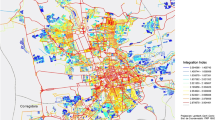Abstract
This study examines the effect of air quality and administrative policies on use of urban trails in Indianapolis, IN. Attention is focused on two policy variables: (1) issuance of air pollution advisories and (2) the adoption of Daylight Savings Time. Results suggest that while trail use varies with air quality, current public advisories regarding air pollution may be of limited effectiveness in reducing trail users’ exposures to hazardous pollutants. In contrast, the adoption of Daylight Savings Time was associated with a statistically significant increase in traffic levels.
Similar content being viewed by others
References
CDC (Centers for Disease Control and Prevention). Behavioral risk factor surveillance system: prevalence data, all States—2007. http://apps.nccd.cdc.gov/brfss/page.asp. Accessed on January 16, 2008.
EPA (Environmental Protection Agency). The green book: nonattainment areas for criteria pollutants. http://www.epa.gov/air/oaqps/greenbk/. Accessed on January 16, 2008.
Carlisle AJ, Sharp NC. Exercise and outdoor ambient air pollution. Br J Sports Med. 2001; 35: 214-222.
Girardot SP, Ryan PB, Smith SM, et al. Ozone and PM2.5 exposure and acute pulmonary health effects: a study of hikers in the Grand Smoky Mountains National Park. Environ Health Perspect. 2006; 114(7): 1044-1052.
Korrick SA, Neas LM, Dockery DW, et al. Effects of ozone and other pollutants on the pulmonary function of adult hikers. Environ Health Perspect. 1998; 106: 93-99.
Sallis JF, Cervero RB, Ascher W, Henderson KA, Kraft MK, Kerr J. An ecological approach to creating active living communities. Annu Rev Public Health. 2006; 27: 297-322.
Marcus BH, Williams DM, Dubbert PM, et al. Physical activity intervention studies: what we know and what we need to know. Circulation. 2006; 114: 2739-2752.
Briggs DJ, de Hoogh K, Morris C, Gulliver J. Effects of travel mode on exposures to particulate air pollution. Environ Int. 2008; 34(1): 12-22.
Lindsey G, Wilson J, Yang J, Alexa C. Urban greenways, trail characteristics and trail use: implications and design. J Urban Des. 2008; 13(1): 107-132.
Lindsey G, Han Y, Wilson J, Yang J. Neighborhood correlates of urban trail traffic. J Phys Act Health. 2006; 1: S134-S152.
NOAA (National Oceanic and Atmospheric Administration). National Climatic Data Center homepage. www.ncdc.noaa.gov/oa/ncdc.html. Accessed on January 23, 2007.
Indiana State Climate Office. Indiana State Climate Office homepage. www.agry.purdue.edu/climate. Accessed on January 23, 2007.
EPA (Environmental Protection Agency). Air Quality System Technology Transfer Network homepage. www.epa.gov/tnn/airs/airsaqs/detaildata/downloadaqsdata.htm. Accessed on January 23, 2007.
Greene WH. Econometric Analysis. New York: Macmillan; 1993.
Gardiner JC, Luo Z, Roman LA. Fixed effects, random effects and GEE: what are the differences? Stat Med. 2009; 28: 221-239.
Uysal N, Schapira RM. Effects of ozone on lung function and lung diseases. Curr Opin Pulm Med. 2003; 9(2): 144-50.
Sarnat JA, Brown KW, Schwartz J, Coull BA, Koutrakis P. Ambient gas concentrations and personal particulate matter exposures: implications for studying the health effects of particles. Epidemiology. 2005; 16(3): 385-395.
Bhatnagar A. Environmental cardiology: studying mechanistic links between pollution and heart disease. Circ Res. 2006; 99(7): 692-705.
Steib DM, Paola J, Neuman K. Do smog advisories work? Results of an evaluation of the Canadian Smog Advisory Program. Can J Public Health. 1996; 87: 166-169.
Johnson BB. Communicating air quality information: experimental evaluation of alternative formats. Risk Anal. 2003; 23(1): 91-103.
Breznitz S. Cry Wolf: The Psychology of False Alarms. Philadelphia: Erlbaum; 1984.
Stewart DW, Martin IM. Intended and unintended consequences of warning messages: a review and synthesis of empirical research. J Public Policy Mark. 1994; 13(1): 1-19.
Bickerstaff K, Walker G. Clearing the smog? Public responses to air quality information. Local Environ. 1999; 4(3): 279-294.
Evans GW, Colome D, Shearer DF. Psychological reactions to air pollution. Environ Res. 1988; 45: 1-15.
Scov T, Cordtz T, Jensen LK, Saugman P, Schmidt K, Theilade P. Modifications of health behavior in response to air pollution notification in Copenhagen. Soc Sci Med. 1991; 33: 621-626.
Johnson BB. Gender and race in beliefs about outdoor air pollution. Risk Anal. 2002; 22: 725-738.
Gobster PH. Recreation and leisure research from an active living perspective: taking a second look at urban trail use data. Leis Stud. 2005; 27: 367-383.
Saelens BE, Sallis JF, Frank LD. Environmental correlates of walking and cycling: findings from the transportation, urban design, and planning literatures. Annals Behav Med. 2003; 25(2): 80-91.
Acknowledgement
The authors gratefully acknowledge financial support from the Active Living Research Program of the Robert Wood Johnson Foundation. The Greenways Division of the Indianapolis Department of Parks and Recreation provided additional technical support.
Author information
Authors and Affiliations
Corresponding author
Rights and permissions
About this article
Cite this article
Holmes, A.M., Lindsey, G. & Qiu, C. Ambient Air Conditions and Variation in Urban Trail Use. J Urban Health 86, 839–849 (2009). https://doi.org/10.1007/s11524-009-9398-8
Received:
Accepted:
Published:
Issue Date:
DOI: https://doi.org/10.1007/s11524-009-9398-8




